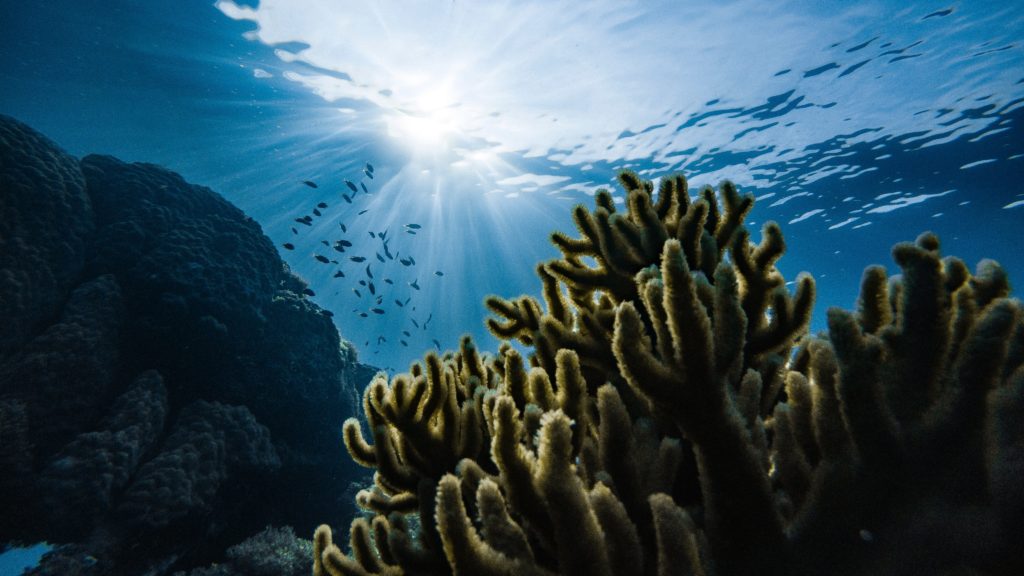UNC marine ecology professor has spent years researching Belizean corals
By: Drew Wayland

Photo by Marek Okon on Unsplash
As reporters, it’s crucial that we have a solid understanding of a place and the problems it faces before we find ourselves working in the field. All of us in Global Storytelling are responsible for educating ourselves on the history, cultures and power dynamics at play in Belize, but the marine science team is tasked with gathering slightly more technical knowledge. We are looking to answer a couple of basic questions: what in the world is coral, and how is it important to Belize and its people?
We didn’t have to look far for someone who could put us on the right track. In fact, we only had to walk next door. Deep in the recesses of UNC-Chapel Hill’s Murray Hall is the Castillo Lab for Ecophysiology, Global Change and Conservation, named for its leading researcher Dr. Karl Castillo, who happens to hail from southern Belize.
I spoke to Castillo, as well as one of his senior student researchers Jared Richards, about the work they’re doing to study coral ecology and adaptability to climate change. We could hardly believe how lucky we were to find one of the only coral ecology labs in the United States (outside of Florida) as well as a number of researchers who had worked extensively with the very reef system we will be visiting in March.
“Although I didn’t consider it for a career until I had left Belize, I have always been very interested in coral and its importance as an animal in the wider ecosystem,” said Castillo.
He talked to me about the common misconception that coral is some kind of plant or even a non-living rock structure. He explained that coral is an extraordinarily sophisticated animal, made up of smaller sub-organisms called polyps. The polyps feed on algae, phytoplankton and other tiny organisms, then secrete material that forms a hard, often colorful exoskeleton.
If you look closely at the structure of coral, you can see that it is covered in tiny pores less than a centimeter across. Each of these pores house a polyp, a fully functional animal in itself with a mouth and a stomach. But only when thousands, or even millions of polyps work together can they create incredibly diverse types of structures and patterns that rival the world’s greatest architects. Each structure is like a building in the underwater metropolis we call a reef.
Since its inception in 2014, the Castillo Lab at UNC has done field work in the Florida Keys, off the coast of Panama and even studied temperate corals near Radio Island, North Carolina. Student researchers take samples from existing reefs and bring them back to Chapel Hill to perform experiments with water temperature, acidity, nitrate levels and sedimentation. The ‘wet lab’ houses all of the coral samples, while the ‘dry lab’ is where students can examine a sample under a microscope or compare their data.
Castillo has been pursuing explanations for a curious coral phenomenon for his entire career, which began more than 20 years ago on a research expedition with the University of South Carolina.
What makes some corals closer to the shoreline respond to climate change differently than deep sea corals? As a young researcher pursuing a master’s degree in marine ecology, Castillo noticed that not all coral exhibits the same behaviors and responses when exposed to the same conditions. Even corals of the same species are dying at much faster rates away from the coast.
“There is no doubt that corals in Belize are being affected by anthropogenic [human] stressors,” said Castillo, “but we have seen a lot of positive news coming out of Belize too. Because it is such a small country, with less than four hundred thousand people, I believe that the Belizean reef has been spared from a lot of the terrible mortality events we’ve seen elsewhere.”
While famous coral structures like Australia’s Great Barrier Reef have lost up to 60% of their coral, the Belizean reef system has seen less than 10% loss since the first mass bleaching event in 1996. This may have something to do with the efforts by the Belizean government to curb development close to the reef and place a moratorium on oil drilling in the country. It may also have to do with the large percentage of the reef lying remarkably close to the shore.
“Almost all of the really bad events, the ones where we don’t see recovery, are happening away from the land, where the water is deeper,” Castillo said. “Right now it’s a bit of a mystery why that is–and that is actually what I’m working on now is a grant proposal to try to study some new findings on this question.”
Jared Richards is a senior at UNC-Chapel Hill. His focus is on something called macro bioerosion, the process of clams, sponges and microbes descending on a reef en masse and eating away at coral exoskeletons.
“When this happens, and it happens more and more often now, it has disastrous effects on the reef,” Richards said. “Farming and other agricultural practices on land put nitrates into the water, which flows out to the ocean and raises the nitrogen level in the water.”
A higher nitrogen level, he explained, leads to faster dissolution of the coral. He and Castillo also laid out some other problems for us to tackle when we get to Belize.
Ocean warming and acidification, of course, are the biggest and most uncontrollable issues. These are tied directly to the extreme levels of carbon-dioxide in the atmosphere, most of which is absorbed by the oceans. As waters around the world warm and become more acidic, corals continue to have trouble adapting. A high enough change in temperature can cause the coral to bleach, a stress response in which the entire exoskeleton turns stark white.
Other issues include invasive species like the lionfish from Southeast Asia driving away important organisms, a new disease called stony coral tissue loss that appeared in Belize as late as October 2019, and the creation of “conch graveyards.” These graveyards are amassed over time as poachers illegally capture conch and scoop the animal out of its shell for conch soup, a Belizean favorite. The shells are then discarded on the seafloor, often in the middle of delicate reefs where they can block light and prevent healthy coral growth.
As the marine science team prepares to cover the impacts of the declining health of the reef on the people of Belize, we will continue to consult Dr. Castillo and his lab for scientific information as well as a Belizean perspective on the threats that are facing this tiny Central American nation.
ABOUT THE AUTHOR

Drew Wayland
Hi, I’m Drew! I’m a writer and reporter studying journalism and creative writing at UNC-Chapel Hill. I DJ a weekly late night radio show and my music taste is probably better than yours!






